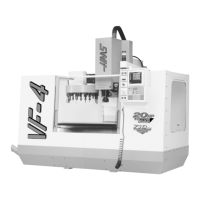172
G CODES
96-8000
June 1999
SEQUENTIAL SERIAL NUMBER ENGRAVING
This method is used to engrave numbers on a series of parts, with the number being incremented by one each
time. The '#' symbol is used to select the number of digits in the serial number. For example:
G47 P1 (#### )
will limit the serial number to four digits.
The initial serial number can be either programmed or set manually. If it is programmed, for example:
G47 P1 (1234)
will set the initial serial number to "1234".
The initial serial number can also be set manually into a macro variable. The "MACROS" option does not have
to be enabled to do this. Macro variables are temporary storage locations for numbers. Macro variable #599 is
used to hold the initial serial number to be engraved. To set this variable, go to the CURNT COMDS page and
press the PAGE DOWN key until the "Macro Variables" page appears. Then type in "599" and press the
(DOWN ARROW). Now enter the desired initial serial number at the cursor and press the WRITE key. For
example, when macro variable #599 is set to "1234",
G47 P1 (####)
will produce this:
1234
If the number in macro variable #599 has more characters than specified in the format string, only the quantity
specified will be printed. For example, if #599 is set to"12345" and only four places are specified in the format
string, only "2345" will be engraved.
LITERAL STRING ENGRAVING
This method is used to engrave desired text on a part. The characters available for engraving are:
A..Z
a..z
0..9,
! " # & ' ( ) * + , / : ; < = > ? [ \ ] ^ { }
However, programs downloaded through the serial port or the floppy drive can take advantage of characters not
available on the mill keypad.
For Literal String Engraving, the text should be in the form of a comment on the same line as the P0 statement.
For example:

